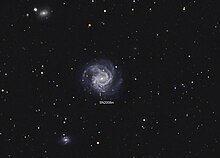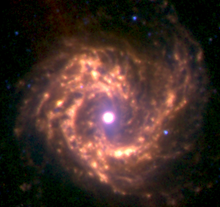Messier 61
Template:Galaxybox begin Template:Galaxybox image Template:Galaxybox observe Template:Galaxybox character Template:Galaxybox astrometry Template:Galaxybox catalog Template:Galaxybox reference Template:Galaxybox end
Messier 61 (also known as M61 or NGC 4303) is an intermediate barred spiral galaxy in the Virgo Cluster of galaxies. It was discovered by Barnaba Oriani on May 5, 1779. This was six days before Charles Messier observed the same galaxy, but had mistaken it as a comet.[1]
Properties
M61 is one of the largest members of Virgo Cluster, and belongs to a smaller subgroup known as the S Cloud.[2][3] The morphological classification of SAB(rs)bc[4] indicates a weakly-barred spiral (SAB) with the suggestion of a ring structure (rs) and moderate to loosely wound spiral arms.[5] It has an active galactic nucleus[6] and is classified as a starburst galaxy containing a massive nuclear star cluster with an estimated mass of 105 solar masses and an age of 4 million years,[7] as well as a central candidate supermassive black hole weighing around 5×106 M☉ solar masses.[8] It cohabits with an older massive star cluster as well as a likely older starburst.[7] Evidence of significant star formation and active bright nebulae appears across M61's disk.[9] Unlike most late-type spiral galaxies within the Virgo Cluster, M61 shows an unusual abundance of neutral hydrogen (H I)[10]
Extragalactic supernovae
Seven extragalactic supernovae have so far been observed in M61, making it one of the most prodigious galaxies for such cataclysmic events.[11][12][1] These include: SN 2014dt, SN 2008in, SN 2006ov, SN 1999gn, SN 1964F, SN 1961I,[12] and the first to be observed, the Type II-K SN 1926A, which appeared on 9 May 1926.[12][13]
Gallery
-
Spiral galaxy Messier 61 is aligned face-on towards Earth.[14]
-
Messier 61 image using data from Hubble's Wide Field Camera 2
-
Amateur Image of Messier 61 Showing Supernova 2008in on April 16, 2009
-
Infrared image of M61 taken by the Spitzer Space Telescope
References
- ^ a b "Messier 61". Archived from the original on 2017-01-06. Retrieved 2017-01-11.
- ^ "Galaxy On Line Database Milano Network (GOLDMine)". Retrieved 2012-08-06.
- ^ "The Virgo Cluster". Retrieved 2013-04-06.
- ^ Cite error: The named reference
nedwas invoked but never defined (see the help page). - ^ de Vaucouleurs, Gérard (April 1963). "Revised Classification of 1500 Bright Galaxies". Astrophysical Journal Supplement. 8: 31. Bibcode:1963ApJS....8...31D. doi:10.1086/190084.
- ^ Jiménez-Bailón, E.; Santos-Lleó, M.; Mas-Hesse, J. M.; Guainazzi, M.; Colina, L.; Cerviño, M.; González Delgado, Rosa M. (2003). "Nuclear Activity and Massive Star Formation in the Low-Luminosity Active Galactic Nucleus NGC 4303: Chandra X-Ray Observations". The Astrophysical Journal. 593 (1): 127–141. arXiv:astro-ph/0304465. Bibcode:2003ApJ...593..127J. doi:10.1086/376554.
- ^ a b Colina, L.; Gonzalez Delgado, R.; Mas-Hesse, J. Miguel; Leitherer, C.; Jimenez Bailon, E. (2002). "Detection of a Super-Star Cluster as the Ionizing Source in the Low-Luminosity Active Galactic Nucleus NGC 4303". The Astrophysical Journal. 579 (2): 545–553. Bibcode:2002ApJ...579..545C. doi:10.1086/342839.
- ^ Pastorini, G.; Marconi, A.; Capetti, A.; Axon, D. J.; Alonso-Herrero, A.; Atkinson, J.; Batcheldor, D.; Carollo, C. M.; Collett, J.; Dressel, L.; Hughes, M. A.; Macchetto, D.; Maciejewski, W.; Sparks, W.; van der Marel, R. (2007). "Supermassive black holes in the Sbc spiral galaxies NGC 3310, NGC 4303 and NGC 4258". Astronomy and Astrophysics. 469 (2): 405–423. arXiv:astro-ph/0703149. Bibcode:2007A&A...469..405P. doi:10.1051/0004-6361:20066784.
- ^ Koopmann, R.; Kenney, J. D. P. (2004). "Hα Morphologies and Environmental Effects in Virgo Cluster Spiral Galaxies". The Astrophysical Journal. 613 (2): 866–885. arXiv:astro-ph/0406243. Bibcode:2004ApJ...613..866K. doi:10.1086/423191.
- ^ Kenney, J. D.; Young, J. S. (1986). "CO in H I-deficient Virgo cluster spiral galaxies". The Astrophysical Journal Letters. 301: L13–L17. Bibcode:1986ApJ...301L..13K. doi:10.1086/184614.
- ^ Supernovae which have been observed in Messier catalog galaxies
- ^ a b c "List of Supernovae". Central Bureau for Astronomical Telegrams. Retrieved 2011-07-03.
- ^ Boffi, F.R.; Sparks, W.B.; Macchetto, F.D. (1999). "A search for candidate light echoes: Photometry of supernova environments". Astronomy and Astrophysics Supplement Series. 138 (2): 253–266. arXiv:astro-ph/9906206. Bibcode:1999A&AS..138..253B. doi:10.1051/aas:1999274.
- ^ "A portrait of a beauty". www.eso.org. Retrieved 7 January 2019.
External links
- messier.seds.org/m/m061.html
- Messier 61 on WikiSky: DSS2, SDSS, GALEX, IRAS, Hydrogen α, X-Ray, Astrophoto, Sky Map, Articles and images

![Spiral galaxy Messier 61 is aligned face-on towards Earth.[14]](http://upload.wikimedia.org/wikipedia/commons/thumb/2/23/Messier61_-_ESO_-_Potw1901a.tif/lossy-page1-216px-Messier61_-_ESO_-_Potw1901a.tif.jpg)



